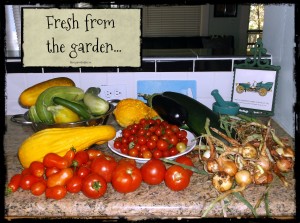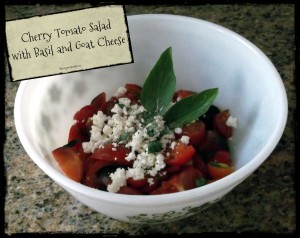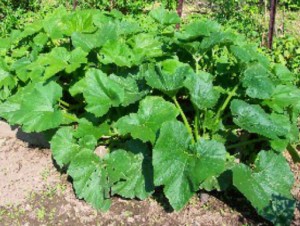How to Harvest for a Self-Sufficient American Diet
 by Daisy Luther
by Daisy Luther
Have you ever thought about how wildly unrealistic and unsustainable our current diets are? Items that don’t grow within the same season are commonly consumed together. Things that don’t grow on the same continent are combined into all sorts of meals. We eat blueberries in December and drink pumpkin spice lattes in the summer. We eat tropical fruit with Midwestern grains. Without the transportation system, there would be absolutely no rhyme or reason to our “normal” diets.
Here’s an example: What’s a typical breakfast in the United States?
Maybe it’s a bowl of Cheerios with milk, a banana sliced on top, and a glass of orange juice.
This sounds pretty normal, right? It’s not – it’s actually quite exotic, if you think about it.
Widget not in any sidebars
Imagine if the grocery store supply lines shut down. If you had to eat what you could acquire without the national food transport network, how likely would it be that you could replicate that breakfast? It seems so simple, but it’s not going to happen.
Think for just a moment about how ridiculous such a combination would have seemed to our ancestors. Let’s forget for a moment that the breakfast mentioned is processed and loaded with GMOs. Let’s just think about the origins of the food.
If you live where wheat is growing, I’m going to guess that you do not live where bananas and oranges are growing. You’ve just invalidated the typical American breakfast in that sentence.
Here’s an example of a breakfast you could acquire at the right time of year without a visit to the store. It took less than 5 minutes to make – it was truly as fast as that hypothetical bowl of cereal with the sliced banana. We picked the berries ourselves a short walk from our home on Friday. The duck eggs came from a nearby farm. It was filling, healthy, and delicious. You could easily add some local meat to the breakfast, or a bowl of porridge made from whatever grain grows nearby (like corn, rice, oats, or quinoa, depending on your location). Nearly every agricultural zone has a grain that grows well if you wish to acquire or farm them.
It’s time to look at your diet very differently, because I can almost guarantee that transit supply line won’t be there indefinitely. And even if the stores do remain open, how long with this food be financially viable? With the petrodollar teetering on the brink of obsolescence, extreme weather causing food shortages across America, and the price of fuel climbing by the day, even if you can acquire the food at your local market, the price is going to increase so dramatically that to get your food from far-flung locales will be completely out of the price range for the average person.
This isn’t even about building a good stockpile. While that ensures you won’t go hungry within a finite period of time, being able to feed yourself from the resources in your area is even more important than a fully loaded pantry.
Many people are so enmeshed in the food transportation system that it would never occur to them to change their lifestyle to a less fuel-dependent one. By adjusting the way you eat to your environment now, you’ll be that much further ahead while the system disintegrates.
What would your diet be like if there was no food transit system?
 So what would you eat if you had to get everything relatively locally?
So what would you eat if you had to get everything relatively locally?
A good place to start is your farmers market. (Find one in your area HERE) If it is a market that is truly for area farmers (i.e., not one that allows vendors to purchase things in the nearest city and present them as fresh and local) then it will give you a good idea what is in season and what grows well in your area. The less expensive the food item is, the closer you are to the heart of the season for that particular fruit or vegetable.
Some other ways to learn about your area’s agriculture:
- Join a gardening group. Even if you are apartment-bound and don’t have the space for a garden of your own, joining a group of local gardeners or homestead-minded people can help you learn about the local growing scene. Facebook abounds with local groups. The bonus is, you can make some friends and learn some skills while you are researching the area.
- See what grows wild. Where I live, there are blackberries everywhere – so many that they are considered an invasive plant! We go blackberry picking several times throughout the summer to help ourselves to nature’s bounty. You can often find fruit and nut-bearing trees along a hiking trail. By learning what grows wild, you can make the best choices for creating your own orchard or garden. If it can grow without any help , the plant will absolutely thrive with a little nurturing.
- Most importantly, see what doesn’t grow in your area. No one grows wheat in the area where I live. The soil here is simply not right for it. They don’t grow bananas because the climate is not right for it. But fresh corn grows like a weed, as do berries and nut trees. If no one farms it in your area, then you will pay a premium price for it if you continue to eat the food while prices escalate.
- Check out your county extension office. There are some amazing resources there for gardening, cooking, and preserving. All of the information you receive there follows regulations from the USDA, but it is still a great (and free) educational resource. In fact, I’m taking advantage of a class at my resource office next moth to learn more about making jerky.
This week, I bought a basket of garden overrun from the lady who supplies us with fresh milk. I got a tremendous amount of vegetables – more than we can possibly eat this week, so I’m going to be preserving them for later in the year when produce is not as abundant. Here’s what I got:
When you look at photos like that, entire meals should come to mind. I am making pickles and salsa for canning. I’m making zoodles with my new spiralizer gadget (I got this one which is currently on sale for only $30: Summer Sale! Spiralizer Tri-Blade Vegetable Slicer, Strongest-and-Heaviest Duty Guarantee Over Paderno and Others, Lifetime Replacement Warranty, Best Veggie Pasta & Spaghetti Maker for Low Carb/Paleo Healthy Vegetable Meals) and then I’ll be dehydrating them.
I’m going to make a serving of marinara and serve it over that eggplant with the ricotta I made this weekend, with some grilled chicken to go along with it. My 13-year-old daughter was instantly inspired to create a salad with basil from our garden, the beautiful mix of heirloom cherry tomatoes, and some goat cheese we got from a vendor at the farmers market.
This is just one example. In a few weeks, peaches will be at the perfect ripeness here in our local orchards. After that, Roma tomatoes will be at their peak. Then it will be apple season. Throughout the summer, there is a decadent amount of fruits and vegetables.
What about the winter, when nothing is growing?
There are lots of different agricultural zones and this is where your county extension office can come in handy yet again. In many areas, with the right set up, you can grow throughout the year.
In some regions, hoop houses and cold frames can extend your growing season 1-2 months on either end of the normal growing season.
As well, you have to plan ahead like our ancestors did. Winter has been coming every year for a long time now – it shouldn’t be a surprise to anyone that it’s coming again this year and that they need to prepare for it. Now is the time to pick and preserve so that you can feed yourself throughout the winter. I’ve canned jams, fruit, coleslaw, tomato juice, pickles, and salsa, and I’m just getting started. This is the busy time of year for those seeking an agrarian lifestyle, because it’s time to start seedlings for a fall garden too.
- Learn more about canning HERE.
- Learn more about dehydrating HERE.
- Learn more about fermenting HERE.
- Learn more about root cellaring HERE.
There are many foods that can be accessed year round. Chickens will continue to lay eggs and dairy animals will continue to provide milk. Meat is also available on a basis other than seasonally.
Seasonal eating is very healthy.
When your fruit needs a passport to get to you, it can’t really be considered ”fresh fruit”. Nature knows just what you need and when you need it.
When you demand produce that is out of season, it’s coming from across the globe. This means that the items were picked before they were actually ripe, which means that the nutrients had not fully developed. The vitamins and minerals contained in produce begin to decrease the minute the food is picked. The harvest item immediately begins to die and decompose. By the time the food arrives at your local grocery store, it might already be 3 weeks old – and sometimes it’s even older.
What’s more, the packing plants take great pains to be sure that the fresh fruits that grace your table at Christmas look pretty. Many packagers add a waxy, glossy coating to the produce before shipping. The coating not only looks shiny and inviting, it slows down the decomposition of the fruit or vegetable. Some foods are sprayed with preservative chemicals, as well, to help them survive the arduous journey to your supermarket.
Reducing the distance your food travels isn’t the only health reason to eat seasonally. Nature provides certain foods at certain times because that is when your body needs them the most. They are also less likely to be drenched in pesticides, fertilizers and fungicides if the plants are growing as nature intended them too.
For example, in the spring, those tender leafy sprigs like lettuce, kale, peas and pea shoots, and asparagus provide vitamins K and folate, which support blood health, bone health, and cell repair. The cool delicate foods are light, low in calories, and rejuvenating to the body as you gear up for the upcoming warm weather. Feasting on these waistline friendly foods is a great way to get rid of that insulating layer of fat that you may have acquired during the winter.
In the summer, delicious berries actually provide protection against the strong rays of the sun. In season foods like corn, peppers, and tomatoes are light on your stomach during the blazing hot weather. Many summer vegetables can be eaten raw and require no cooking, so you don’t have to heat up your house to prepare them.
In the fall, you should begin to look for foods that provide more warmth – carrots, sweet potatoes, apples, and pumpkins, to name a few. As well, the beta-carotene in many of these autumn treats will boost the body’s germ fighting cells to strengthen your immune system for the upcoming cold and flu season.
Finally in the winter, you should consider eating more carbohydrates like those from root vegetables – they help the body to sustain a little more weight, which is needed to insulate against the cold weather. Warming vegetables like potatoes, cabbages, carrots, onions, rutabagas, and winter squash all store well in cool, dark places, providing energy and comfort throughout the winter season. Adding more fish to your diet during this time of year is also beneficial for the warming effect, the higher calories, and the high levels of vitamin D (the vitamin you get directly from the sun during the warmer months). Vitamin D is important for good mental health and a strong immune system.
Nuts, which store well for the winter, are loaded with Omega 3 fatty acids, which help moisturize your body from the inside out – this helps to fight that dry winter skin so many of us suffer from. (source)
It’s great for your budget.
 By growing what you can and acquiring things when they are at their most abundant, you’ll save a lot of money. As I discussed above, there are several current economic issues that are going to cause the price of our “average American diets” to skyrocket. Reliance on long-distance food at the grocery store will simply be financially unsustainable.
By growing what you can and acquiring things when they are at their most abundant, you’ll save a lot of money. As I discussed above, there are several current economic issues that are going to cause the price of our “average American diets” to skyrocket. Reliance on long-distance food at the grocery store will simply be financially unsustainable.
When gas prices continue to climb, that cost is going to be pushed off on the end consumer: the person buying that food (or other item) from the store. The farther the item has to come to get from you, the more fuel it takes to get it here. Soon, those December blueberries will be out of reach for all but the wealthiest of families. Why not pick your blueberries in the summer and can or freeze them if you want to have blueberries in December? Then you’ll pay $2 a pound instead of $9 a pound.
You must also take into consideration the extreme weather over the past couple of years. The drought in California has meant that many farmers are letting formerly productive fields lie fallow so that they can concentrate their limited water supply on the remaining fields. This will, in turn, cause a shortage of those particular foods, which will make them more expensive, based on the laws of supply and demand.
However, this doesn’t have to affect you as badly as it will those who rely solely on the grocery store to get their food.
Things are still growing, and they are probably growing near you. I cheerfully take those huge clubs of zucchini that my neighbors don’t know what to do with and I preserve them for the winter ahead. There is still a lot of abundance in our country, the thing is, that abundance near you is happening RIGHT NOW, not in 6 months. You have to think ahead by getting things while they are at their peak – at this point in time people with gardens have a tremendous amount of overflow. The key to making this help your budget is saving that overflow for later, when it will be outrageously expensive to get it from the store.
You don’t have to be an expert to grow food.
Well, I sure hope not, otherwise we’ll starve. I have grown gardens before. Some have been so successful that they looked like a lush jungle in my yard, while others have wilted, laying down in defeat in the blazing sun. I’m definitely not a master gardener. I wouldn’t even say I have a particularly green thumb. (Just summon a medium and ask some of my victims – I am like the serial killer of once-thriving house plants). I’m telling you this so you know that anyone can do it if they have the desire to do so: no genetically inherited alien-colored digit is required.
You don’t have to be an expert, but you do have to be determined. You have to be willing to ask questions of others in your area who have been growing for years. You have to observe the things growing in your region. You have to be willing to put in hard work and get dirty. And if something dies, you have to cut your losses and try something else. I recently thought I had killed my herb garden during the last heat wave. I uprooted everything – it was all wilted and semi-dead looking, and repotted in containers, which I moved to a shadier location. I lost some plants but more than half of them surprised me by bouncing back. From this I learned two things: 1) Where NOT to plant herbs next year and 2) If it’s already dying, what can it hurt to try something new? It might finish the plant off or it might give it a chance to rejuvenate.
Most of all, realize that if you keep plugging away at it, you can grow food. If other people in your area are growing food, it can be done. If it can be done, you can do it too. For centuries, this was how people got enough food to eat and the human race hasn’t died out yet. This means that, given a little bit of space, you can grow food too.
Chime in!
What’s growing in your area right now? How are you preserving it? Do you have suggestions for those who are in a situation where they can’t grow a garden? And how are your plans coming along to join the Grocery Store Rebellion on August 1?
Daisy Luther is a freelance writer and editor. Her website, The Organic Prepper, where this first appeared, offers information on healthy prepping, including premium nutritional choices, general wellness and non-tech solutions. You can follow Daisy on Facebook and Twitter, and you can email her at [email protected]
If you enjoyed this article, please Vote for The Organic Prepper as a top prepping web site.








